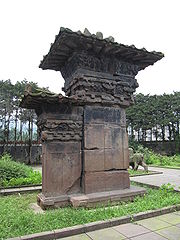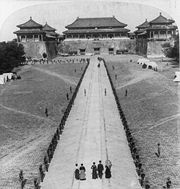
Que (tower)
Encyclopedia

Gate tower
A gate tower is a tower built over or next to a major gateway.Usually it is part of a medieval fortification. This may be a town or city wall, a fortress or a castle. The gate tower may be built as a twin tower on either side of an entranceway. Even in the design of modern building complexes, gate...
in traditional Chinese architecture. First developed in the Zhou Dynasty
Zhou Dynasty
The Zhou Dynasty was a Chinese dynasty that followed the Shang Dynasty and preceded the Qin Dynasty. Although the Zhou Dynasty lasted longer than any other dynasty in Chinese history, the actual political and military control of China by the Ji family lasted only until 771 BC, a period known as...
, que towers were used to form ceremonial gateways to tombs, palaces and temples throughout pre-modern China down to the Qing Dynasty
Qing Dynasty
The Qing Dynasty was the last dynasty of China, ruling from 1644 to 1912 with a brief, abortive restoration in 1917. It was preceded by the Ming Dynasty and followed by the Republic of China....
. The use of que gateways reached its peak during the Han Dynasty
Han Dynasty
The Han Dynasty was the second imperial dynasty of China, preceded by the Qin Dynasty and succeeded by the Three Kingdoms . It was founded by the rebel leader Liu Bang, known posthumously as Emperor Gaozu of Han. It was briefly interrupted by the Xin Dynasty of the former regent Wang Mang...
, and today they can often be seen as a component of an architectural ensemble (a spirit way
Spirit way
A spirit way is the ornate road leading to a Chinese tomb of a major dignitary.The term is also sometimes translated as spirit road, spirit path or sacred way....
, shendao) at the graves of high officials during China's Han Dynasty
Han Dynasty
The Han Dynasty was the second imperial dynasty of China, preceded by the Qin Dynasty and succeeded by the Three Kingdoms . It was founded by the rebel leader Liu Bang, known posthumously as Emperor Gaozu of Han. It was briefly interrupted by the Xin Dynasty of the former regent Wang Mang...
. There are also some que found in front of temples. Richly decorated, they are among the most valuable survived relics of the sculpture and architecture of that period.
Que in the Han Dynasty
It is thought that the que familiar to us are stone reproductions of the free-standing wooden and/or earthen towers which were placed in pairs in front of the entrances to the palaces, temples, and government buildings of the period (already known during the Qin DynastyQin Dynasty
The Qin Dynasty was the first imperial dynasty of China, lasting from 221 to 207 BC. The Qin state derived its name from its heartland of Qin, in modern-day Shaanxi. The strength of the Qin state was greatly increased by the legalist reforms of Shang Yang in the 4th century BC, during the Warring...
). Such free-standing towers, serving as markers of the symbolic boundary of a palace's or temple's premises, had developed from gate towers that were an integral part of a building or a city wall. None of such que in front of buildings have survived, but images of buildings with such towers in front of them can be seen on extant brick reliefs in Han Dynasty tombs, such as the one in Yinan County
Yinan County
Yinan is a county of Linyi in the Chinese province of Shandong.The population was in 1999.-Notable people:...
, Shandong).
At the spirit roads, the que also appeared in pairs, one on each side of the road. During the time of their popularity, the que were usually the largest and most expensive component of the spirit way; such a tower could cost 4 times as much as a stone lion, or 10 times as much as a memorial stele.
The symbolic meaning of a tomb que may have been based on that of the que in front of a palace and building. Here, it would symbolize the passage of the soul into the world of the spirits. A tall vertical structure, que would at the same time symbolize a link with heaven.
The use of que on spirit ways declined after the fall of the Eastern Han. Some que from the 3rd and 4th century have been founded in Sichuan, but, as Ann Paludan notes, only in the province's more remote and presumably culturally conservative parts. Generally, after the Eastern Han era, the role of que on the spirit way was assumed by huabiao
Huabiao
Huabiao is a type of ceremonial columns used in traditional Chinese architecture. Huabiaos are traditionally erected in front of palaces and tombs. The prominence of their placement have made them one of the emblems of traditional Chinese culture. When placed outside palaces, they can also be...
pillars.
Around 30 que have survived to the present day. Most of them are in Sichuan
Sichuan
' , known formerly in the West by its postal map spellings of Szechwan or Szechuan is a province in Southwest China with its capital in Chengdu...
; a few in Henan
Henan
Henan , is a province of the People's Republic of China, located in the central part of the country. Its one-character abbreviation is "豫" , named after Yuzhou , a Han Dynasty state that included parts of Henan...
and Shandong
Shandong
' is a Province located on the eastern coast of the People's Republic of China. Shandong has played a major role in Chinese history from the beginning of Chinese civilization along the lower reaches of the Yellow River and served as a pivotal cultural and religious site for Taoism, Chinese...
. According to Ann Paludan
Ann Paludan
Ann Paludan is a British author of several books on Chinese history, sculpture, and architecture.-Biography:Ann Paludan is the daughter of Basil Murray...
, this distribution may be explained by two reasons. First, there may have been more stone que produced in these regions in the first place, due to the ready availability of stone and the tradition of stone-working craft; meanwhile elsewhere wooden que were built, which have not survived. Second, Sichuan has more remote, hard to access areas, which is exactly where many of the Han Dynasty que have managed to survive. The locations around the imperial capitals, where the Eastern Han imperial mausolea were located, saw more intensive level of destruction over the almost 2000 years that have elapsed since that era, and the que constructed there did not have a chance to survive.
Many of the Sichuan que were first made known to the international scholarship by Victor Segalen
Victor Segalen
Victor Segalen was a French naval doctor, ethnographer, archeologist, writer, poet, explorer, art-theorist, linguist and literary critic....
, who described them during his 1914 expedition.
Que after the Han dynasty


Tang Dynasty
The Tang Dynasty was an imperial dynasty of China preceded by the Sui Dynasty and followed by the Five Dynasties and Ten Kingdoms Period. It was founded by the Li family, who seized power during the decline and collapse of the Sui Empire...
usually featured que, and remnants can still be seen today. They also remained in use in gateways to the imperial palaces down to the end of the imperial era. Ultimately, they were combined with a more conventional gateway to form a single U-shaped structure, where a conventional gate would be connected, via two "arms" extending outwards, to two que towers. The final two examples of such combined que gates were found as the Meridian Gate
Meridian Gate
The Meridian Gate is the southern gate of the Forbidden City. It has five arches. The three central arches are close together; the two flanking arches are farther apart from the three central arches...
s, the southern and main entrances, to the imperial palaces of Nanjing
Nanjing
' is the capital of Jiangsu province in China and has a prominent place in Chinese history and culture, having been the capital of China on several occasions...
and Beijing
Beijing
Beijing , also known as Peking , is the capital of the People's Republic of China and one of the most populous cities in the world, with a population of 19,612,368 as of 2010. The city is the country's political, cultural, and educational center, and home to the headquarters for most of China's...
. The ques in Nanjing were demolished in 1924 to make way for the construction of the Ming palace airfield. The gate in Beijing survives intact. Despite being a single structure, the que is identified distinctly from the gate. Two que pavilions with pyramidal roofs mark out the que from the rest of the gate house.
Examples
- Tomb of Fan Min in Lushan County, SichuanLushan County, SichuanLushan County, Sichuan is a county of Sichuan Province, China. It is under the administration of Ya'an city.-Historical Monuments:An ancient monument, located in Lushan County and dating to 205 AD of the Eastern Han Dynasty, is the remains of the mausoleum of Fan Min...
. This is also where the oldest known tortoise-borneBixi (tortoise)Bixi , also called guifu or baxia , is a stone tortoise, used as a pedestal for a stele or tablet. Tortoise-mounted stelae have been traditionally used in the funerary complexes of Chinese emperors and other dignitaries. Later, they have also been used to commemorate an important event, such as...
stele is located. - Mausoleum of the Shen family, Qu CountyQu CountyQu County is a county of Sichuan Province, China. It is under the administration of Dazhou city.-History:Formerly known as Dangqu , the county is best known for historic monuments. Namely, a partially preserved mausoleum complex, featuring gate towers, or que, belonging to the Shen family, which...
, Sichuan - Tomb of Gao Yi, Ya'anYa'anYa'an is a prefecture-level city in the western part of Sichuan province of Southwest China, located just below the Tibetan Plateau.-History:...
, Sichuan - Liye Tower, Zitong CountyZitong CountyZitong County is a county in Mianyang City, Sichuan Province of China.It has an area of 1438 square kilometers, and a population of 380,000 in 2002. It is 172 kilometers from Chengdu, and 49 kilometers from Mianyang, and is regarded as a pearl on the economic development golden line in Sichuan.The...
, Sichuan

